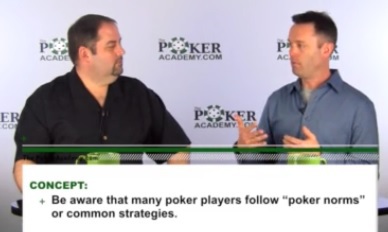The Poker Academy Session 9: Reading Your OpponentsA Session By Session Look At The Poker Academy's No-Limit Hold'em Tournament Course |
|
|
 Join us as we take a closer look at the 12-session course from the brilliant strategic minds at The Poker Academy. Every two weeks, Card Player will break down the curriculum from poker pro Rick Fuller and two-time WSOP bracelet winner Rep Porter, to detail the positive impact that The Poker Academy can have on your game.
Join us as we take a closer look at the 12-session course from the brilliant strategic minds at The Poker Academy. Every two weeks, Card Player will break down the curriculum from poker pro Rick Fuller and two-time WSOP bracelet winner Rep Porter, to detail the positive impact that The Poker Academy can have on your game.
Sign up today, and win a $1,000 buy-in to a 2016 WSOP event, round-trip airfare to Las Vegas, and a three night stay at the Rio hotel.
Last time we looked at session 8, Playing The Stages Of A Tournament. Let’s move on through the course.
Session 9: Reading Your Opponents
By this point in the course, site instructors Rep Porter and Rick Fuller have given you a solid, fundamental approach to the no-limit hold’em poker tournaments that will make your competitive. But the last four sessions of the course will show you how to deviate from the standard in order to adjust and play optimally against a wide range of opponents.
This session is all about learning how to observe and classify your opponents, as well as how to spot tells.
“A lot of this is more about art than science,” said Porter. “It takes more observations to really feel like you know what is going on. A lot of reading your opponents outside of betting patterns and the actual cards you see at showdown is about observing tendencies and patterns in their actions and reactions.”
While reliable tells can be very useful, the course cautions that tells should really only be used during close decisions. The second video in the course focuses on how to observe your opponents and spot betting patterns to narrow down their range. Often by just replaying the action in your mind, you can eliminate quite a bit of an opponents range.
 The third video allows you to classify and label different character types. Profiles need to be flexible because they are based on educated guesses, not concrete information. Characteristics from your opponents can chance from preflop to postflop.
The third video allows you to classify and label different character types. Profiles need to be flexible because they are based on educated guesses, not concrete information. Characteristics from your opponents can chance from preflop to postflop.
The fourth course video discusses physical tells and how to spot the ordinary from the out of character. Tells can mean completely different things depending on if its coming from an actor or a non-actor. With non-actors, if they act weak, then they are probably weak. With actors, if they act weak, then they are probably strong. Other tells can include how players bet their chips and what they say during the hand.
Next time, we’ll take a look at session 10, Adjustments For Opponent Types.
If you’d like to take your game to the next level, sign up for The Poker Academy today.
